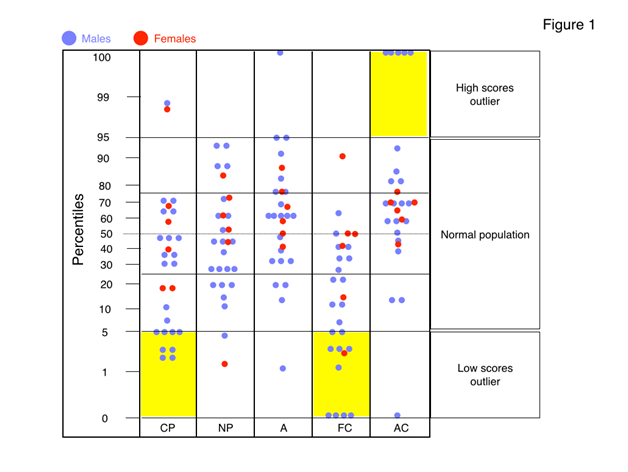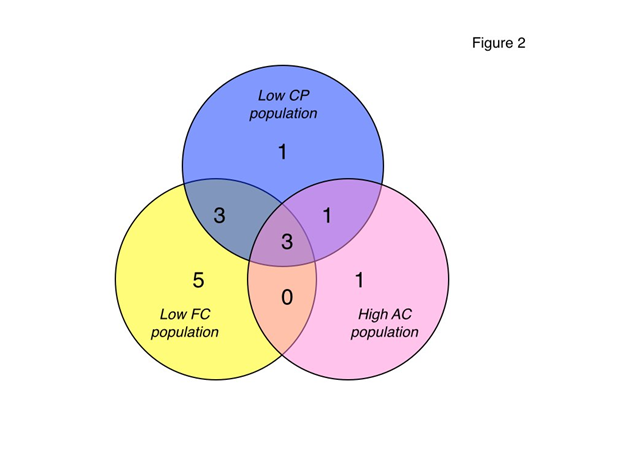Journal of
eISSN: 2373-6445


Research Article Volume 4 Issue 2
1Department of Psychiatry, Teikyo University Chiba Medical Center, Japan
2Department of Psychiatry, Graduate School of Medicine, Chiba University, Japan
Correspondence: Katsumasa Muneoka, Department of Psychiatry, Teikyo University Chiba Medical Center, 3426-3 Anesaki, Ichihara 299-0111, Japan
Received: September 01, 2015 | Published: October 23, 2015
Citation: Muneoka K, Takahashi M, Ishiwata S, Suzuki M, Sato K, Shirayama Y (2015) Low Critical Parent Ego State is a Marker of Treatment-Resistant Depression in a Self-Rating Ego gram Questionnaire. J Psychol Clin Psychiatry 4(2): 00186. DOI: 10.15406/jpcpy.2015.04.00186
Background: In transactional analysis theory, ego states are a part of an individual’s personality. Neurobiological, psychological, and social factors are involved in treatment-resistant depression.
Methods: This study was conducted to assess ego states defined during the transactional analysis of treatment-resistant depression: Critical Parent, Nurturing Parent, Adult, Free Child, and Adapted Child. A total of 28 patients that were diagnosed with treatment-resistant depression (22 men and 6 women; mean age ± SD, 40.0 ± 8.0 and 33.1 ± 5.5years, respectively) were subjected to this examination in an outpatient clinic. Ego states were scored using the TEG self-rating questionnaire.
Results: Three specific profiles, Low Critical Parent, Low Free Child, and High Adapted Child ego states were extracted. These three deviated ego states were overlapped in individuals, especially in male patients.
Conclusion: Low Critical Parent ego state is thought to be a marker of treatment-resistant depression and TEG is useful to detect pathological ego states in treatment-resistant depression.
Keywords:transactional analysis, ego, treatment-resistant depression, critical parent
TRD, treatment-resistant depression; HAM-D, hamilton depression rating scale
Up to 15% of patients with depression do not show significant clinical response despite pharmacological and psychotherapeutic approaches.1 Depression is generally considered treatment-resistant depression (TRD) when at least two trials with distinct antidepressants do not produce a significant improvement, although TRD is a heterogeneous condition.1,2 Evidence indicates that there are multiple possible approaches to treating TRD, and suggests that neurobiological, psychological, and social factors are involved in TRD. Thus, social isolation and problematic personal traits such as "neuroticism" are associated with poor response to therapeutic approaches.2 The necessity of cognitive and interpersonal therapy2 and the amelioration of social support3 have been emphasized in the treatment of TRD.
In transactional analysis theory, ego states are a part of an individual’s personality at a given time.4,5 The Egogram presents five spectra in a bar-chart analysis of a person’s functional ego states,6 which are categorized as "Critical Parent", "Nurturing Parent", "Adult", "Free Child", and "Adapted Child". Originally, ego states in people are observed and evaluated by psychologists intuitively through the interpersonal relationship between clients and psychologists.4 A questionnaire has been developed that makes the evaluation of ego states more convenient.7 Self-rating questionnaire sheets, such as the TEG (Tokyo University Egogram)8 or Egogram Check List,9 have been widely used in clinical or occupational settings in Japan. There are clinical studies using self-rating egogram in fields of functional somatic syndromes,10,11 psycho-oncology,12 occupational health care,8 and psychiatric disorders (e.g., anorexia and bulimia nervosa).13 This is a result of applying a self-rating egogram, TEG to 28 patients with TRD.
Participants
A total of 28 TRD patients (22 men and 6 women; mean age±SD, 40.0±8.0 and 33.1±5.5years, respectively) that visited an outpatient clinic of Teikyo University Chiba Medical Center (Ichihara, Chiba, Japan) from 2008 to 2012 were subjected to this examination. Patients were assessed by two senior-level psychiatrists and met the Diagnostic and Statistical Manual of Mental Disorders, Fourth Edition criteria for major depressive disorder as the first episode of depression.14 Participants did not meet any other axis I criteria in the DSM-IV and were free of any physical illness. Inclusion criteria for TRD required symptoms of moderate depression evaluated as scoring³14 on the 17-item Hamilton Depression Rating Scale (HAM-D)15 after treatment with at least two antidepressants for 8weeks. Scores on the 17-item HAM-D were 19.3±4.4 in men and 16.1±2.4 in women (mean±SD). Durations of illness were 37.6 ± 22.8months for men and 35.1±13.3months for women (mean±SD). The study was approved by the ethics committee of Teikyo University Chiba Medical Center and performed in accordance with the Declaration of Helsinki. Written informed consent was obtained from all participants after the procedures had been fully explained.
Measures
Ego states were evaluated using the TEG (new version II, published by Kaneko-Shobo, Tokyo, Japan). The TEG is comprised of 60 items.8 Briefly, in the written questionnaire, the participant was asked to rate each item as yes, no, or intermediate, which were respectively scored as 2, 0, or 1 point. Cumulative scores are interpreted as the magnitude of each ego state. The total numbers of points in each ego state category were converted to percentile values according to standardization that had been conducted for men and women with scores obtained from healthy Japanese individuals.8 Spectra in the TEG indicate individual personality, and there are no standard ranges to function as normal values in each ego. Results were evaluated on the basis of percentile values and scores £5th and ³95th percentile are defined as outliers (Figure 1)
Results
From the data of percentile plotting, three groups of outliers can be extracted as indicated with yellow color (Figure 1): Low Critical Parent, Low Free Child, and High Adapted Child. In total, 10 participants scored above the 95th percentile: 2 in Critical Parent, 3 in Adult, and 5 in Adapted Child. Twenty-three participants scored below the 5th percentile: 8 in Critical Parent, 2 in Nurturing Parent, 1 in Adult, 11 in Free Child, and 1 in Adapted Child (Figure 1). Furthermore, some participants are in more than one outlier group (Figure 2). Thus, three participants were in both Low Critical Parent and Low Free Child outlier groups, while one participant was in both Low Critical Parent and High Adapted Child outlier groups. Three participants were members of three overlapping outlier groups: Low Critical Parent, Low Free Child, and High Adapted Child.

Figure 1 Plots of percentile values in each ego state in TRD patients. CP, Critical Parent; NP, Nurturing Parent; A, Adult; FC, Free Child; AC, Adapted Child.

Figure 2 The number of study participants in groups with Low Critical Parent (CP), Low Free Child (FC), and High Adapted Child (AC). The numbers of participants that belong to more than one outlier group are indicated in the overlaps of the figures.
Discussion
In clinical setting, Critical Parent indicates a critical and controlling ego state, and Nurturing Parent indicates a nurturing and sympathetic ego state. Adult indicates an ego state as a grown-up person. Free Child indicates an uncensored, childlike ego state, and Adapted Child indicates an ego state in which no responsibility is felt and behavior is designated to conform to what others expect.8 Moreover, the cognitive behavioral approach is practiced on the basis of personal egograms in Japan. The present study suggests a specific profile in the ego states of TRD patients: low scores in Critical Parent associated with low Free Child and high Adapted Child. With the exception of one participant in the Low Free Child group with no overlap with other outlier groups, all participants that scored as Low Critical Parent, Low Free Child, or High Adapted Child were men. This suggested profile may typically be expressed in men.
In a study of healthy people8 and a study of outpatients who consulted a department of psychosomatic medicine,16 Critical Parent was positively correlated with Anger-Hostility (A-H) in Profile of Mood States (POMS)17 and Adapted Child was positively correlated with Tension-Anxiety (T-A), Depression (D), and Confusion (C) in POMS. In a study of outpatients, Free Child was positively correlated with Vigor in POMS.16 Furthermore, Critical Parent and Adapted Child were positively correlated with scores of the Zung Self-Rating Depression Scale.16 In addition, a study using the Egogram Checklist has demonstrated a pattern: Adapted Child is higher than Free Child in patients with "white coat" hypertension, suggesting an over-adaptive attitude among these patients.10 Moreover, high Adapted Child is associated with dependence and avoidance.8 From these results, it can be expected that Critical Parent and Adapted Child are high in depression. Low Free Child is also expected to be low in depression due to their suppressed activity and loss of interest in things. Therefore, it is conceivable that the observation of high Adapted Child and low Free Child in TRD patients is consistent with previous results of depression. In contrast, low Critical Parent is a finding opposite the finding of high Critical Parent that has been reported previously in depression. Low Critical Parent may be a psychological profile that is specific for TRD.
Critical Parent represents a critical and controlling ego state and resembles the superego in that both are thought to be formed through an internalization of value judgments imposed by an individual's early caregivers. Taken together, it is speculated that function of superego that may be related to critical attitude in social and individual activity and motivation by moral values is impaired in TRD, especially in males.
Low Critical Parent ego state is a diagnostic marker of TRD and this can be detected using a self-rating egogram TEG in clinical setting. This psychological pathology might be a therapeutic target in psychotherapy and pharmacotherapy in TRD.
None.
Author declares there are no conflicts of interest.
None.

©2015 Muneoka, et al. This is an open access article distributed under the terms of the, which permits unrestricted use, distribution, and build upon your work non-commercially.